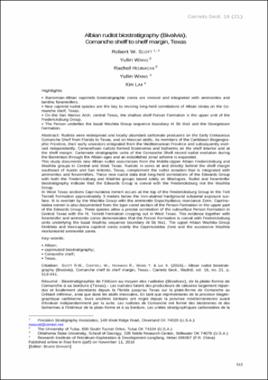| dc.contributor.author | Scott, Robert W. | |
| dc.contributor.author | Campbel, Whitney | |
| dc.contributor.author | Hojnacki, Rachel | |
| dc.contributor.author | Wang, Yulun | |
| dc.contributor.author | Lai, Xin | |
| dc.date.accessioned | 2019-08-21T22:01:29Z | |
| dc.date.available | 2019-08-21T22:01:29Z | |
| dc.date.issued | 2016-11-11 | |
| dc.identifier | oksd_scott_albianrudistbi_2016 | |
| dc.identifier.citation | Scott, R. W., Campbel, W., Hojnacki, R., Wang, Y., & Lai, X. (2016). Albian rudist biostratigraphy (Bivalvia), Comanche shelf to shelf margin, Texas. Carnets de G�ologie, 16(21), 513-541. https://doi.org/10.4267/2042/61701 | |
| dc.identifier.uri | https://hdl.handle.net/11244/321200 | |
| dc.description.abstract | Rudists were widespread and locally abundant carbonate producers on the Early Cretaceous Comanche Shelf from Florida to Texas, and on Mexican atolls. As members of the Caribbean Biogeographic Province, their early ancestors emigrated from the Mediterranean Province and subsequently evolved independently. Comanchean rudists formed biostromes and bioherms on the shelf interior and at the shelf margin. Carbonate stratigraphic units of the Comanche Shelf record rudist evolution during the Barremian through the Albian ages and an established zonal scheme is expanded. This study documents new Albian rudist occurrences from the Middle-Upper Albian Fredericksburg and Washita groups in Central and West Texas. Rudists in cores at and directly behind the shelf margin southeast of Austin and San Antonio, Texas, complement the rudist zonation that is integrated with ammonites and foraminifers. These new rudist data test long-held correlations of the Edwards Group with both the Fredericksburg and Washita groups based solely on lithologies. Rudist and foraminifer biostratigraphy indicate that the Edwards Group is coeval with the Fredericksburg not the Washita Group. In West Texas sections Caprinuloidea romeri occurs at the top of the Fredericksburg Group in the Fort Terrett Formation approximately 3 meters below the iron-stained hardground subaerial exposure surface. It is overlain by the Washita Group with the ammonite Eopachydiscus marcianus Zone. Caprinuloidea romeri is also documented from the type cored section of the Person Formation in the upper part of the Edwards Group. These species allow a precise correlation of the subsurface Person Formation in Central Texas with the Ft. Terrett Formation cropping out in West Texas. This evidence together with foraminifer and ammonite zones demonstrates that the Person Formation is coeval with Fredericksburg units underlying the basal Washita sequence boundary Al Sb Wa1. The upper Albian Washita Group Kimbleia and Mexicaprina caprinid zones overly the Caprinuloidea Zone and the successive Washita mortonicerid ammonite zones. | |
| dc.format | application/pdf | |
| dc.language | en_US | |
| dc.publisher | Carnets de Geologie | |
| dc.rights | This material has been previously published. In the Oklahoma State University Library's institutional repository this version is made available through the open access principles and the terms of agreement/consent between the author(s) and the publisher. The permission policy on the use, reproduction or distribution of the material falls under fair use for educational, scholarship, and research purposes. Contact Digital Resources and Discovery Services at lib-dls@okstate.edu or 405-744-9161 for further information. | |
| dc.title | Albian rudist biostratigraphy (Bivalvia), Comanche shelf to shelf margin, Texas | |
| osu.filename | oksd_scott_albianrudistbi_2016.pdf | |
| dc.description.peerreview | Peer reviewed | |
| dc.identifier.doi | 10.4267/2042/61701 | |
| dc.description.department | Geology | |
| dc.type.genre | Article | |
| dc.type.material | Text | |
| dc.subject.keywords | albian | |
| dc.subject.keywords | caprinuloid biostratigraphy | |
| dc.subject.keywords | comanche shelf | |
| dc.subject.keywords | texas | |
